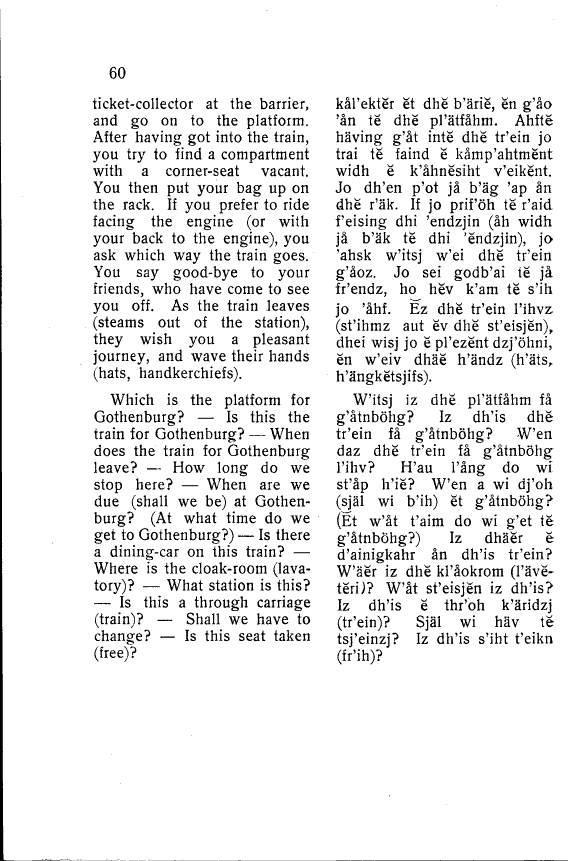
Full resolution (TIFF) - On this page / på denna sida - Läsestycken - 28. Travelling by Train

<< prev. page << föreg. sida << >> nästa sida >> next page >>
Below is the raw OCR text
from the above scanned image.
Do you see an error? Proofread the page now!
Här nedan syns maskintolkade texten från faksimilbilden ovan.
Ser du något fel? Korrekturläs sidan nu!
This page has never been proofread. / Denna sida har aldrig korrekturlästs.
60
ticket-collector at the barrier,
and go on to the platform.
After having got into the train,
you try to find a compartment
with a corner-seat vacant.
You then put your bag up on
the rack. If you prefer to ride
facing the engine (or with
your back to the engine), you
ask which way the train goes.
You say good-bye to your
friends, who have come to see
you off. As the train leaves
(steams out of the station),
they wish you a pleasant
journey, and wave their hands
(hats, handkerchiefs).
Which is the platform for
Gothenburg? — Is this the
train for Gothenburg? — When
does the train for Gothenburg
leave? — How long do we
stop here? — When are we
due (shall we be) at
Gothenburg? (At what time do we
get to Gothenburg?) — Is there
a dining-car on this train? —
Where is the cloak-room
(lavatory)? — What station is this?
— Is this a through carriage
(train)? — Shall we have to
change? — Is this seat taken
(free)?
kål’ektĕr ĕt dhĕ b’äriĕ, ĕn g’åo
’ån tĕ dhĕ pl’ätfåhm. Ahftĕ
having g’åt inte dhĕ tr’ein jo
trai tĕ faind ĕ kåmp’ahtmĕnt
widh ĕ k’åhnĕsiht v’eikĕnt.
Jo dh’en p’ot jå b’äg ’ap ån
dhĕ r’äk. If jo prif’öh tĕ r’aid
f’eising dhi ’endzjin (åh widh
jå b’äk tĕ dhi ’endzjin), jo
’ahsk W’itsj w’ei dhĕ tr’ein
g’åoz. Jo sei godb’ai tĕ jå
fr’endz, ho hĕv k’am tĕ s’ih
jo ’åhf. Ez dhĕ tr’ein l’ihvz,
(st’ihrnz aut ĕv dhĕ st’eisjĕn),
dhei wisj jo ĕ pl’ezĕnt dzj’öhni,
ĕn w’eiv dhäĕ h’ändz (h’äts,
h’ängkĕtsjifs).
W’itsj iz dhĕ pl’ätfåhm få
g’åtnböhg? Iz dh’is dhĕ
tr’ein få g’åtnböhg? W’en
daz dhĕ tr’ein få g’åtnböhg
l’ihv? H’au l’ång do wi
st’åp h’iĕ? W’en a wi dj’oh
(själ wi b’ih) ĕt g’åtnböhg?
(Et w’åt t’aim do wi g’et tĕ
g’åtnböhg?) Iz dhäĕr ĕ
d’ainigkahr ån dh’is tr’ein?
W’äer iz dhĕ kl’åokrom
(l’ävĕ-tĕri)? W’åt st’eisjĕn iz dh’is?
Iz dh’is ĕ thr’oh k’äridzj
(tr’ein)? Själ wi hav té
tsj’einzj? Iz dh’is s’iht t’eikn
(fr’ih)?
<< prev. page << föreg. sida << >> nästa sida >> next page >>